
As 2015 comes to a close, we’ve seen that more companies, marketers and salespeople are embracing the inbound philosophy than ever before—but not all are achieving success.
We’ve collected 6 statistics from the most successful inbound marketers and explore what they are doing right from the upcoming State of Inbound 2015 report. Want a copy of the full report? Enter your email below and we’ll send you a copy as soon as it’s published.
Are you already doing these things? Keep it up! It’s only a matter of time until you get the momentum you’re looking for.
Are you not doing these things and looking for better results? Give them a try! While it may not seem relevant for your business, there are lessons to be learned across all industries.
1. Companies are 3X more likely to see higher ROI on inbound marketing campaigns than on outbound.
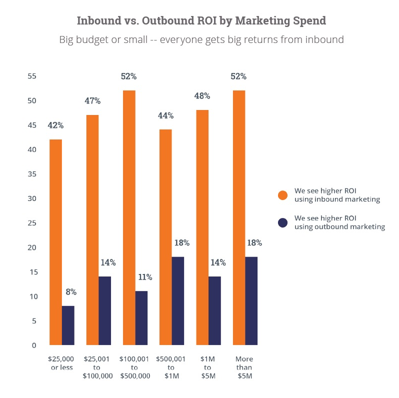
Think the success of inbound marketing only applies to companies of certain sizes? Think again! Across the board, the majority of companies of all sizes saw significantly increased returns from leveraging inbound marketing (blogging, webinars, free content) vs. outbound marketing (cold calls, list purchases, media buy).
2. Marketers who check their metrics 3X+ a week are 20% more likely to achieve positive ROI.
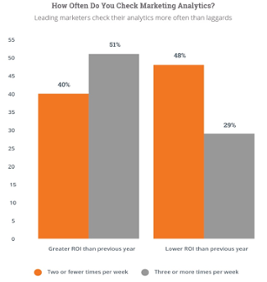
You can’t make informed changes and improvements if you’re not keeping an eye on what your data is telling you and how it’s changing over time. Regular monitoring of your analytics is foundational to success and can help to turn failures into victories. Staying informed on how your data is performing helps marketers know what not to invest in, and how to reallocate budget into more fruitful areas of return. Note that you need to be measuring the right metrics—not just vanity metrics! It’s important to look at metrics that can inform action, otherwise you are just looking at a bunch of pretty charts.
3. Marketers who tracked ROI were 20% more likely to receive a budget increase than their counterparts who did not track ROI.
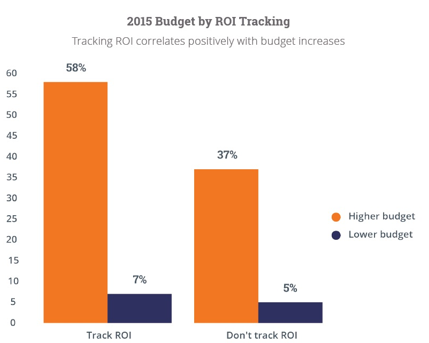
If you gave me a $5 investment, and I told you I’d give you back more than $5, but I’m not sure how much more, or when, or how, and I probably wouldn’t be able to tell if we actually do see a return, would you really give me MORE money the next year? No way!
You’re probably already regretting giving me that five-spot. Your executives are simply not going to keep throwing money into a black pit without knowing what they are getting back from it. Companies at this stage often view their marketing department as “cost-centers” since they do not see any returns generated from marketing efforts. On the flip-side, marketers who prove ROI have much greater success as the data speaks for itself. Companies at this stage often view their marketing department as “revenue-centers” and their sophisticated modeling efforts enable greater budgets to achieve even greater success and marketing is seen as an indispensable component of revenue success.
4. Marketers using a marketing automation tool were 11% more likely to achieve greater ROI than those not using marketing automation
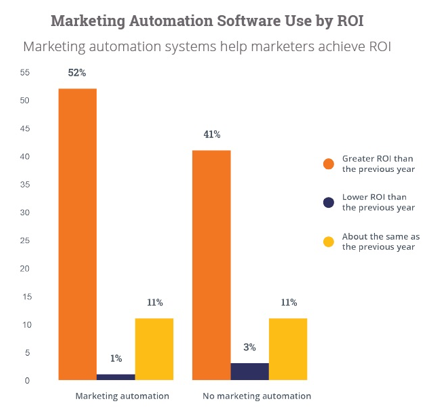
Marketing automation platform (MAP) tools and technology are growing at an astonishing pace. Just as it would be unheard of for most brands not to have some type of software platform to manage their social media accounts, marketing automation software will soon become status quo. Simply having the tool will not be enough to realize ROI, as it requires strategy, thoughtfulness, technology expertise, and time to start reaping the rewards from an MA tool. However, those who embrace marketing automation sooner will have a significant advantage over their competitors who have not yet adopted and mastered the technology.
The time to get your MAP readiness plan in place is now!
5. Companies with established SLA’s were 12% more likely to achieve greater ROI than those with no SLA.
An SLA is a service level agreement which helps to align marketing and sales to ensure both business units are accountable to each other. Having an SLA in place helps to avoid the back and forth bickering from the “Marketing isn’t getting enough leads” and “Sales isn’t closing the leads we’re bringing” debate.
An SLA clearly defines the number of visitors, leads, and customers that the company needs to bring in and the projected conversion/close rates as leads move through the funnel. Both Sales and Marketing agree to these numbers so everyone is working off of the same playbook. The goal is not to punish those who aren’t holding up their end of the bargain, but rather to help identify weak links and develop solutions to improve and optimize their performance.
It doesn’t take a long time to develop an SLA, and with a 12% increase in the likelihood to achieve greater ROI, why wouldn’t you draft one?
6. Marketers who were involved with sales software selection were 13% more likely to see a positive ROI, and 11% more likely to receive an increased budget.
Integrating a marketing automation platform (MAP) and a customer relationship management (CRM) tool is one of the most vital elements to get right in order to effectively report on ROI and understand marketing’s influence on your leads and customers. Often times, each business unit is operating in a vacuum. As a result, when the time comes to integrate either the tools are incompatible, or the strategy and infrastructure work has not been completed causing delays, higher costs, and inefficient operations. Knowing this, it’s no surprise that companies that involve marketing in sales software decisions achieve greater ROI and a higher budget vs. those companies who do not involve marketing.
Do you agree or disagree with these findings? Share your thoughts along with your predictions for 2016, and don’t forget to sign up for the full report in the form above.



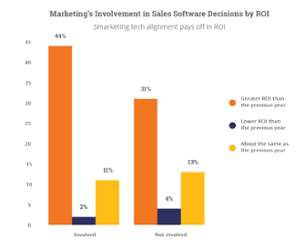
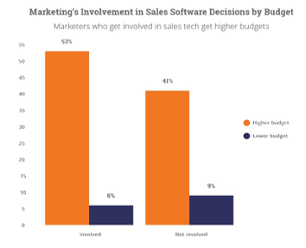

Sorry, the comment form is closed at this time.